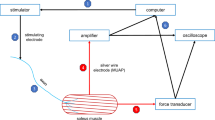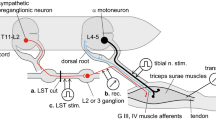Summary
-
1.
The influence of spinal cord temperature on the stretch responses of primary and secondary muscle spindle endings of triceps surae, anterior tibialis, and extensor digit. longus was tested in 27 anesthetized cats.
-
2.
During the early phase of isolated spinal cooling the spontaneous activity, the acceleration response, and the dynamic response of primary afferents increased while the static response remained unchanged. With further cooling and with the appearance of shivering in most cases, however, the spontaneous activity, the acceleration responses, and the dynamic responses of primary endings dropped to lower values than at normal temperatures but not so the static responses. These findings suggest a parallel activation followed by an inactivation of both the dynamic γ-trail fibres and the static γ-plate fibres to muscle spindles. The decrease in spontaneous activity seemed to be more pronounced in extensor muscles than in flexor muscles. With secondary endings all changes were much less than with primary endings.
-
3.
The decreased dynamic sensitivity of the primary endings leads to a decreased stability in the proprioceptive feedback loop of muscle innervation. This may support the inherent tendency of oscillation and hence the initiation and subsistence of shivering.
-
4.
Tremor as induced by curare perfusion of the third ventricle is enhanced by spinal cord cooling but diminished by spinal warming.
Zusammenfassung
-
1.
In insgesamt 27 Versuchen wurde der Einfluß der Rückenmarkstemperatur auf die Dehnungsempfindlichkeit primärer und sekundärer Muskelspindelafferenzen aus dem M. triceps surae, M. tibialis ant. und M. ext. digit. long. geprüft.
-
2.
Im Beginn einer Temperatursenkung im Wirbelkanal kam es meistens zu einer Zunahme der Spontanaktivität, der Beschleunigungs- und der dynamischen Antwort der primären Afferenzen, während die statische Antwort relativ unbeeinflußt blieb. Mit weiter fortschreitender Kühlung und dem Auftreten von Zittern jedoch sank in der Mehrzahl der Fälle die Spontanaktivität, die Beschleunigungs-und die dynamische Antwort der primären Afferenzen unter die Werte bei Normaltemperatur ab, nicht jedoch die statische Antwort. Diese Veränderungen der verschiedenen, für die Beurteilung der Dehnungsempfindlichkeit wichtigen Kriterien deuten auf eine gleichsinnige Aktivierung bzw. Inaktivierung sowohl des dynamischen als auch des statischen γ-Systems hin. Alle Änderungen waren mit der Wiedererwärmung reversibel. Die Verminderung der Spontanaktivität bei länger bestehender Kühlung schien bei Extensoren ausgesprochener zu sein als bei Flexoren. Bei den sekundären Afferenzen waren die Änderungen wesentlich geringer als bei den primären Afferenzen.
-
3.
Die verminderte dynamische Empfindlichkeit der primären Spindelreceptoren hat einen Stabilitätsverlust des proprioceptiven, längenstabilisierenden Rückmeldekreises der Muskelinnervation zur Folge. Sie fördert somit die dem System inhärenten Neigungen zu Oscillationen und begünstigt die Entstehung und Unterhaltung eines Tremors.
-
4.
Bei einem durch Curare-Perfusion des 3. Ventrikels ausgelösten Tremor verstärkte eine zusätzliche Rückenmarkskühlung sowohl die Verminderung der dynamischen Antwort der primären Afferenzen als auch den Tremor. Eine Erwärmung des Rückenmarks verminderte den schon bestehenden Curare-Tremor.
Similar content being viewed by others
Literatur
Alnaes, E., J. K. S. Jansen, andT. Rudjord: Fusimotor activity in the spinal cat. Acta physiol. scand.63, 197–212 (1965).
Appelberg, B.: The effect of electrical stimulation of nucleus ruber on the gamma motor system. Acta physiol. scand.55, 150–159 (1962a).
— The effect of electrical stimulation in nucleus ruber on the response to stretch in primary and secondary muscle spindle afferents. Acta physiol. scand.56, 140–151 (1962b).
Barker, D.: The motor innervation of the mammalian muscle spindle. InGranit, R. (Editor): Muscular afferents and motor control. Stockholm: Almquist and Wiksell 1966.
— The structure and distribution of muscle receptors. InBarker, D. (Editor): Symposium on muscle receptors. Hong Kong: Hong Kong University Press 1962.
—, andM. C. Ip: The primary and secondary endings of the mammalian muscle spindle. J. Physiol. (Lond.)153, 8P-10P (1960).
Barron, D. H., andB. H. C. Matthews: Dorsal root reflexes. J. Physiol. (Lond.)94, 26P-27P (1938).
Bessou, P., F. Emonet-Denand, andY. Laporte: Occurrence of intrafusal muscle fibres innervation by branches of slow α-motor fibres in the cat. Nature (Lond.)198, 594–595 (1963).
—Y. Laporte etB. Pages: Similitude des effects (statiques ou dynamiques) exercés par des fibres fusimotrices uniques sur les terminaisons primaires de plusieurs fuseaux chez le chat. J. Physiol. (Paris)58, 31–39 (1966).
Birzis, L., andA. Hemingway: Efferent brain discharge during shivering. J. Neurophysiol.20, 156–166 (1957).
Boyd, I. A.: The structure and innervation of the nuclear bag muscle fibre system and nuclear chain muscle fibre system in mammalian muscle spindles. Phil. Trans. Sect. B245, 81–136 (1962).
— Discussion on muscle spindles. InGranit, R. (Editor): Muscular afferents and motor control. Stockholm: Almquist and Wiksell 1966.
Bremer, F.: Strychnine tetanus of the spinal cord. InWolstenholme, G. E. W. (Editor): CIBA Symposium, the spinal cord. Boston: Little Brown & Comp. 1953.
Brooks, C. McC., K. Koizumi, andJ. L. Malcolm: Effects of changes in temperature on reactions of spinal cord. J. Neurophysiol.18, 205–216 (1955).
Brown, M. C., A. Crowe, andP. B. C. Matthews: Observations on the fusimotor fibres of the tibialis posterior muscle of the cat. J. Physiol. (Lond.)177, 140–159 (1965).
Bruggencate, H. G. ten, H. D. Henatsch, andH. Bossmann: Reduction of dynamic sensitivity of primary muscle spindle endings in experimental tremor. Experientia (Basel)20, 554–555 (1964).
Bruggencate, H. G. ten, H. D. Henatsch, andH. Bossmann: Tremor und spinalmotorische α- und γ-Systeme der Katze bei Curare-Perfusion der Hirnventrikel. Pflügers Arch. ges. Physiol.282, 102–118 (1965).
Burton, A. C., andO. G. Edholm: Man in a cold environment. London: E. Arnold Publ. Ltd. 1955.
Carpenter, D. O., andE. Henneman: A relation between the threshold of stretch receptors in skeletal muscle and the diameter of their axons. J. Neurophysiol.29, 353–368 (1966).
Crowe, A., andP. B. C. Matthews: The effects of stimulation of static and dynamic fusimotor fibres on the response to stretching of the primary endings of muscle spindles. J. Physiol. (Lond.)174, 109–131 (1964a).
—— Further studies of static and dynamic fusimotor fibres. J. Physiol. (Lond.)174, 132–151 (1964b).
Feldberg, W.: A pharmacological approach to the brain from its inner and outer surface. London: E. Arnold Publishers Ltd. 1963.
Granit, R.: Receptors and sensory perception. New Haven: Yale University Press 1955.
—O. Pompeiano, andB. Waltman: Fast supraspinal control of mammalian muscle spindles: extra- and intrafusal co-activation. J. Physiol. (Lond.)147, 385–398 (1959).
Haase, J., u.H. J. Schlegel: Einige funktionelle Merkmale von α-innervierten Extensor- und Flexor-spindeln der Katze. Pflügers Arch. ges. Physiol.287, 163–175 (1966).
Henatsch, H. D.: Spinal motor systems and dynamic/static properties of muscle spindles in experimental tremor states of the cat. InGranit, R. (Editor): Muscular afferents and motor control. Stockholm: Almquist and Wiksell 1966.
—, andS. S. Schäfer: Fusimotor-sensor and fusimotor-trigger functions: A reinterpretation of the dual control of mammalian muscle spindles. Brain Res.6, 385–387 (1967).
Hess, A.: Two kinds of motor nerve endings on mammalian intrafusal muscle fibres as revealed by the cholinesterase technique. Anat. Rec.139, 173–184 (1961).
Hongo, T., andH. Shimazu: Centrifugal modifications of discharge rates of primary and secondary endings of muscle spindles in the hind limb of the cat. J. Neurophysiol.28, 724–741 (1965).
Hunt, C. C.: Relation of function to diameter in afferent fibres of muscle nerves. J. gen. Physiol.38, 117–131 (1954).
—, andE. R. Perl: Spinal reflex mechanism concerned with skeletal muscle. Physiol. Rev.40, 538–579 (1960).
Jansen, J. K. S., andP. B. C. Matthews: The central control of the dynamic response of muscle spindle receptors. J. Physiol. (Lond.)161, 357–378 (1962).
Jessen, C., E. Simon u.R. Kullmann: Untersuchungen zur Thermosensitivität von Rückenmark und Hypothalamus am wachen Hund. Pflügers Arch. ges. Physiol.300, R44 (1968).
Klussmann, F. W.: Der Einfluß der Temperatur auf die afferente und efferente motorische Innervation des Rückenmarks. I. Temperaturabhängigkeit der afferenten und efferenten Spontantätigkeit. Pflügers Arch.305, 295–315 (1969).
—, u.H. D. Henatsch: Der Einfluß der lokalen Rückenmarkstemperatur auf die Dehnungsempfindlichkeit der Muskelspindeln. Pflügers Arch. ges. Physiol.283, R17 (1965).
Luschnat, K.-D.: Die Eigenreflexerregbarkeit des menschlichen Rückenmarks als Schwingungsvorgang. Pflügers Arch. ges. Physiol.258, 431–451 (1954).
— Schwingungsfähigkeit im zentralen Teil des Eigenreflexbogens. Pflügers Arch. ges. Physiol.262, 502–516 (1956).
Matthews, P. B. C.: Muscle spindles and their motor control. Physiol. Rev.44, 219–289 (1964).
— The differentiation of two types of fusimotor fibre by their effects on the dynamic response of muscle spindle primary endings. Quart. J. exp. Physiol.47, 324–333 (1962).
Merton, P. A.: The silent period in a muscle of the human hand. J. Physiol. (Lond).114, 183–198 (1951).
Meurer, K.-A., C. Jessen u.M. Iriki: Kältezittern während isolierter Kühlung des Rückenmarks nach Durchschneidung der Hinterwurzeln. Pflügers Arch. ges. Physiol.293, 236–255 (1967).
Partridge, L. D., andG. H. Glaser: Adaptation in regulation of movement and posture. A study of stretch responses in spastic animals. J. Neurophysiol.23, 257–268 (1960).
Perkins, J. F., Jr.: The role of the proprioceptors in shivering. Amer. J. Physiol.145, 264–271 (1946).
Pringle, J. W. S., andV. J. Wilson: The response of a sense organ to a harmonic stimulus. J. exp. Biol.29, 220–234 (1952).
Rautenberg, W.: Die zentrale Thermosensitivität beim Vogel und ihre Bedeutung für die Temperaturregulation. Pflügers. Arch. ges. Physiol.291, R75 (1966).
—, u.E. Simon: Die Beeinflussung des Kältezitterns durch lokale Temperaturänderung im Wirbelkanal. Pflügers Arch. ges. Physiol.281, 332–345 (1964).
Schäfer, S. S.: The acceleration response of a primary muscle-spindle ending to ramp stretch of the extrafusal muscle. Experientia (Basel)23, 1026 (1967).
—, u.H. D. Henatsch: Dehnungsantworten der primären Muskelspindelafferenz bei elektrischer Reizung und natürlicher Innervation der beiden fusimotorischen Fasertypen. Exp. Brain Res.4, 275–291 (1968).
Schomburg, E. D.: Fusimotorische Förderung und Hemmung bei Pinna-Reizung in Abhängigkeit vom zentralnervösen Zustand. Pflügers Arch.304, 164–182 (1968).
Sherrington, C. S.: Notes on temperature after spinal transection, with some observations on shivering. J. Physiol. (Lond.)58, 405–424 (1924).
Shimazu, H., T. Hongo, andK. Kubota: Two types of central influences on gamma motor system. J. Neurophysiol.25, 309–323 (1962a).
——— Nature of central regulation of muscle spindle activity. InBarker, D. (Editor); symposium on muscle receptors. Hong Kong: Hong Kong University Press 1962b.
Simon, E., W. Rautenberg, R. Thauer u.M. Iriki: Die Auslösung von Kältezittern durch lokale Kühlung im Wirbelkanal. Pflügers Arch. ges. Physiol.281, 309–331 (1964).
Steg, G.: Efferent muscle innervation and rigidity. Acta physiol. scand.61, Suppl. 225 (1964).
Stuart, D., K. Ott, K. Ishikawa, andE. Eldred: The rhythm of shivering. II. Passive proprioceptive contributions. Amer. J. phys. Med.45, 75–90 (1966).
—, andR. W. Porter: Proprioceptive contributions to shivering. Fed. Proc.23, 567 (1964).
Tönnies, J. F.: Reflex discharge from the spinal cord over the dorsal roots. J. Neurophysiol.1, 378–390 (1938).
Wilson, V. J., andM. Kato: Excitation of extensor motoneurons by group II afferent fibers in ipsilateral muscle nerves. J. Neurophysiol.28, 545–554 (1965).
Author information
Authors and Affiliations
Rights and permissions
About this article
Cite this article
Klussmann, F.W., Henatsch, H.D. Der Einfluß der Temperatur auf die afferente und efferente motorische Innervation des Rückenmarks. Pflugers Arch. 305, 316–339 (1969). https://doi.org/10.1007/BF00592258
Received:
Issue Date:
DOI: https://doi.org/10.1007/BF00592258




